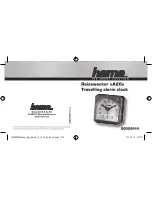
Page
1
of
2
CQR338-
140820
REV. 3
CQR338
Conventional Photoelectric Smoke and Heat
Detector
Installation, Testing &
Maintenance Instructions
1. TYPICAL WIRING DIAGRAM
Figure 1 below shows a typical wiring diagram for a
2-wire multiple device detector system.
DO NOT PLACE LINKS BETWEEN THE WIRING POSITIONS OF
TERMINALS 2 AND 5 TO PROVIDE POWER SUPERVISION
Figure 2 below shows the typical wiring diagram for a
4-wire multiple device detector system.
DO NOT PLACE LINKS BETWEEN THE WIRING POSITIONS OF
TERMINALS 2 AND 5 TO PROVIDE POWER SUPERVISION
IMPORTANT WARNING
TO
PREVENT
DETECTOR
CONTAMINATION
AND
SUBSEQUENT
WARRANTY
CANCELLATION,
THE
SMOKE DETECTOR MUST REMAIN COVERED UNTIL
THE AREA IS CLEAN AND DUST FREE.
2. INSTALLING THE BASE
1. To ensure the correct installation of the detector head
to the base, all the wires should be correctly installed:
(A) Position all the wires flat against terminals.
(B) Fasten the wires away from connector terminals.
2. If you used a jumper wire to connect the poles of
terminal 2 and 5 when testing the detector loop
continuity, be sure to remove the jumper wire prior to
the installation of the detector head.
3. The end-of-line device shown in figure 1 should be
compatible with the control panel.
4. Open area smoke detectors are intended for mounting
on a ceiling or a wall in accordance with the fire
standard in your country.
5. The base of the smoke detector can be mounted
directly onto an electrical junction box such as an
octagonal (75mm, 90mm or 100mm), a round (75mm),
or a square (100mm) box without using any type of
mechanical adapter.
3. ADJUSTING THE RELAY FOR NC/NO
(4 wire version only)
The normal condition for the relay is
“
normally closed
”
(NC).
To adjust the normal condition of the relay to
“
normally
open
”
(NO),
a.
Remove the 2 screws beneath the label on the back
of the detector head.
b.
Insert a screwdriver into the rectangular hole located
on the side between the front cover and base and
rotate to remove the front cover.
c.
Refer to figure 3. There is a jumper head next to the
relay on the PCB. Remove the jumper head and
reinsert it in the NO position.
d.
Carefully replace the front cover and refit the screws
Relay contact rating:
1A@30VDC
0.5A@125VAC,
4. INSTALLING THE HEAD
1. Align the alignment mark on the detector head to the
short alignment mark on the base as shown in
Figure 4.
2. Place the detector head onto the base and twist
clockwise to secure it.
3.
Do not install the detector head until the area is
thoroughly cleaned of construction debris, dusts, etc.
(The maximum number of detectors installed on the
same zone/circuit is 30, this maybe lower depending
on the local regulation)
+
-
Control
Panel
Power to
detectors
First/Next detector base
Last detector base
Zone/Circuit
connections
EOL Power
supervisor relay
5
2
6
1
3
4
5
2
6
1
3
4
+
+
+ -
-
EN54 listed
compatible
control panel
Zone
Loop
Connections for
Remote Indicator
First/Next detector base
Last detector base
5
2
6
1
3
4
EOL
Device
-
+
5
2
6
1
3
4
+
-
+
-
-
+
+
+
-
-
Control
Panel
Power to
detector
5
2
6 1
3 4
5
2
6 1
3 4
First detector base
Last detector base
Zone / Circuit
connections
-
+
+
+
-
-
Control
Panel
Power to
detector
5
2
6 1
3 4
5
2
6 1
3 4
First detector base
Last detector base
Zone / Circuit
connections
-
+
+
+
-
-
Control
Panel
Power to
detector
5
2
6 1
3 4
5
2
6 1
3 4
First detector base
Last detector base
Zone / Circuit
connections
See section 3 to configure the output type
the default setting is Normally Closed
Smoke Chamber
Relay
Jumper setting
LED
Detector head
LED
Base
Short alignment mark
Long alignment mark
Rectangular
Opening here
Figure 4. Placing the detector head onto base
Figure 3. Schematic of detector structure
When front cover is open.
-




















